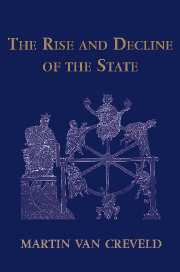Book contents
Conclusions: beyond the state
Published online by Cambridge University Press: 26 June 2009
Summary
As presented in this study, government and state are emphatically not the same. The former is a person or group which makes peace, wages war, enacts laws, exercises justice, raises revenue, determines the currency, and looks after internal security on behalf of society as a whole, all the while attempting to provide a focus for people's loyalty and, perhaps, a modicum of welfare as well. The latter is merely one of the forms which, historically speaking, the organization of government has assumed, and which, accordingly, need not be considered eternal and self-evident any more than were previous ones.
The first place to see this particular form of government was Western Europe, where it started developing around 1300 and where the decisive changes took place between the death of Charles V in 1558 and the Treaty of Westphalia ninety years later. Speaking very roughly, and skipping over the many differences that separated various countries, the process worked as follows. Having fought and defeated universalism on the one hand and particularism on the other, a small number of “absolute” monarchs consolidated territorial domains and concentrated political power in their own hands. Simultaneously, in order to wield both the civilian and military aspects of that power, they set out to construct an impersonal bureaucracy as well as the tax and information infrastructure necessary for its support.
- Type
- Chapter
- Information
- The Rise and Decline of the State , pp. 415 - 421Publisher: Cambridge University PressPrint publication year: 1999



